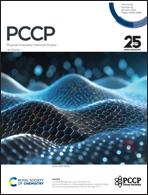Gamma-ray dose threshold for MAPbI3 solar cells†
Abstract
In this work, we report on the effects observed in MAPbI3 polycrystalline films and solar cells under moderate gamma-ray doses of 3–21 kGy. We applied several instrumental techniques such as photoluminescence spectroscopy, time-resolved photoluminescence, Suns-VOC measurement, and impedance spectroscopy to characterize exposed samples. We observed a nonlinear dependency of such characteristics as PL intensity, career lifetime, ideality factor, and recombination resistance on the exposure dose. Small doses of 3–5 kGy annihilate some of the defect centers in the material, which results in improved carrier extraction and prolonged carrier lifetime, while with larger doses of 10 kGy and above, nonradiative recombination becomes predominant. In this way, we revealed a gamma-ray threshold for MAPbI3 films of around 10 kGy, above which it is not recommended to exploit this material. In space environment, yearly doses rarely exhibit 0.1 kGy (10 krad), and the MAPbI3 material has a sufficient margin of safety for space applications. Moreover, this unusual behaviour opens up the opportunity to use gamma-ray sources as an effective method to improve the quality of defective polycrystalline perovskite films before actual exploitation in an ionizing radiation-free environment.

- This article is part of the themed collection: 2024 PCCP HOT Articles


 Please wait while we load your content...
Please wait while we load your content...